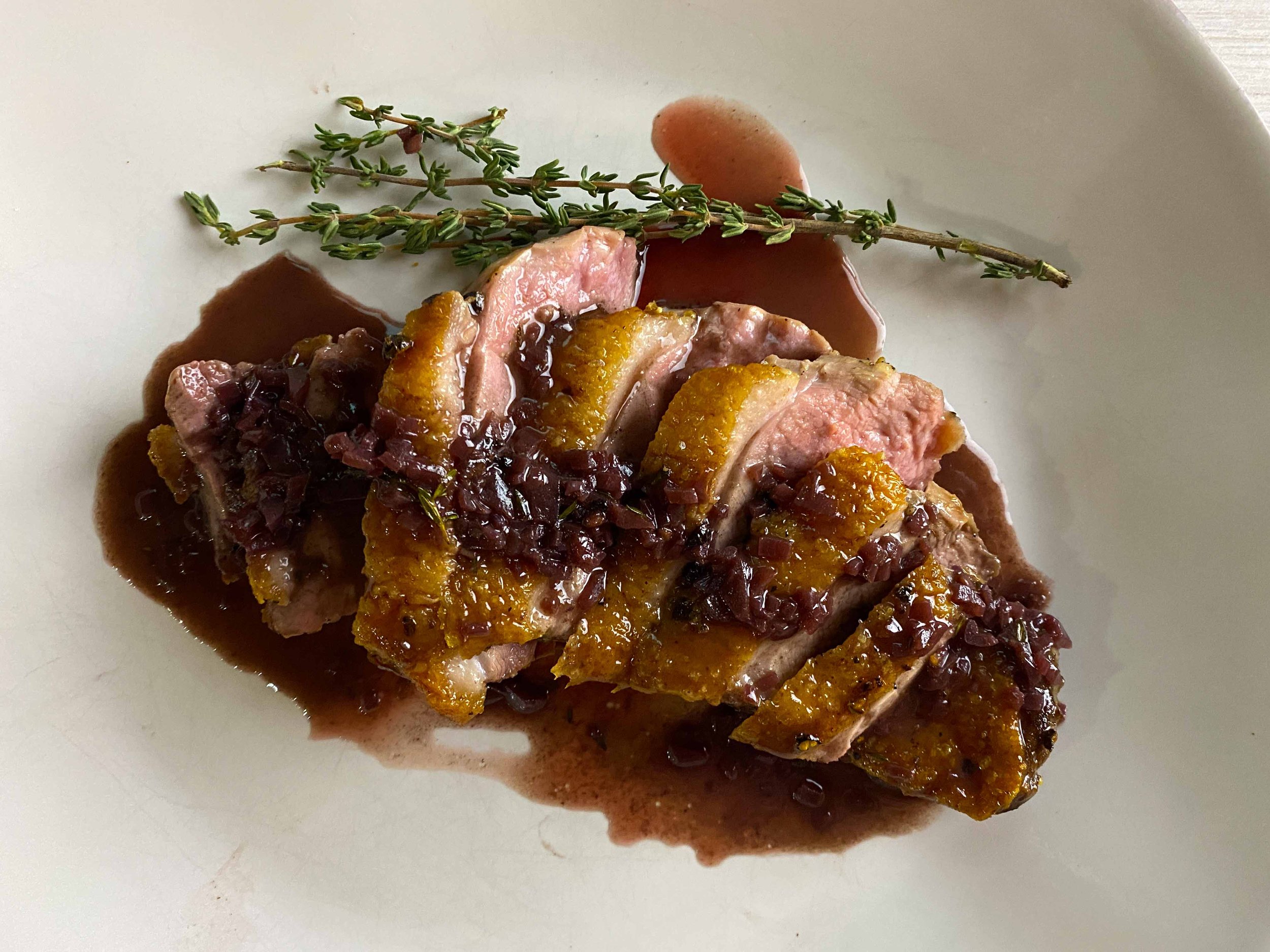By Leslie Brenner
What is the favorite food of people who live in France — steak frites? Boeuf bourguignon? Quiche? Mais non — it’s magret de canard, a dish most Americans probably have never heard of.
In the last four or five years, magret — duck breast cooked medium-rare like a steak — has risen to the top of the popularity charts and stayed there. In bistros and restaurants from Paris to Nantes, from Bordeaux to Toulouse, and Montpelier to Lyon, and in kitchens of home cooks from the most basic to the foodiest, magret is everywhere.
Though the preparation may be slightly different, it’s usually easy to recognize: deep rosy-pink-to-red slices, each edged with a pad of golden-brown-edged fat. There might be sauce, or perhaps not. It’s sometimes grilled, and often cooked à la poêle (in a pan). If there is a sauce, it is probably not sweet, as it would be in the United States; more likely something like a red wine sauce. (Yes, duck à l’orange exists in France, but it’s not the most usual preparation.) It looks more like red meat than poultry.
The flavor? Superb — rich and lean somehow at the same time, delightfully ducky, and not gamey (at least as long as it’s not overcooked). This is why the French love it: It’s delicious.
As these things go, its rise to the pinnacle of popularity has been dizzying. By most accounts, the dish was invented by André Daguin, owner and chef of the Hôtel de France in Auch, a small town in Gascony, around 1959. The hotel restaurant was known for (among other things) its outstanding confit duck legs, a specialty of the region. One day, suddenly tired of wasting the duck breasts, Daguin was struck by an idea: Grill them rare and serve them as if they were steaks. He called the dish Lou Magret. (That’s Occitaine dialect for “le maigre” — the lean.) Reportedly he served it with a duck-fat sauce béarnaise, later switching it to green peppercorn sauce.
Robert Daley, a Times correspondent writing a travel story in 1971, described Lou Magret’s presentation this way:
“Daguin lifted it onto a plate. From a silver casserole he added tiny potatoes that had been sautéed in butter, and all over this he spooned a thin green sauce with fresh peppercorns in it.”
Just one small problem with the conventional — and widely reported — wisdom about Daguin having invented the dish: He himself told Daley that he had not. “Absolutely not,” Daley quoted him as saying.
“The Hotel de France has been in my family since 1926, and we’ve served it all that time. My grandfather was a famous chef as well, and I know he served it back in the 1890’s.”
Unfortunately, Daguin died in 2018, so we can’t ask him to clarify. I did ask his daughter Ariane Daguin, via email, what she knows about it. She is founder of D’Artagnan, the pioneering New York-based purveyor that supplies duck products (including foie gras, breasts and legs) to restaurants and home cooks around the United States. Daguin has not yet responded. (When and if she does, we will update this article.)
Whether it was Ariane Daguin’s father or great-grandfather who first served magret, no question but that it was her father who popularized it — putting Gascony on the world culinary map at the same time.
Magret waiting to be cooked
How to make magret
If you visit France and you’re an omnivore, you will want to order it. (In fact, it’s hard to avoid!) In the meantime, it’s a fabulous thing to make at home.
Because the duck breast is covered with a thick layer of fat — most of which needs to be rendered — it can be a bit tricky to cook it medium-rare. But take it slow, cook it rather low, and you’ll nail it. Cook it once or twice, and you’ll get the knack — and feel pretty brilliant about the extremely French dish you can turn out with very little effort. It’s special enough to impress yet quick and easy enough for a weeknight dinner.
Prick the skin all over with a toothpick to help the fat render. (Many recipes have you score the fat, but pricking it is easier and equally effective.) Season with salt and pepper, place skin-side-down in a cold skillet, give it high heat for half a minute till it sizzles, then cook about 15 minutes on medium-low. No need to touch it during that time, so you can set the table, or make a veg, or mince a shallot for the pan sauce. Flip it skin-side up — the fat will be mostly rendered and the skin will be a beautiful, crisp golden-brown. Cook a minute or two on the flesh side till medium-rare. Make a quick pan sauce while the breasts rest for 10 minutes. Slice the breasts, sauce ‘em up and you’re in for a treat. Here’s an actual recipe.
Serve them with haricots verts — French string beans, and (if you’re feeling expansive) potatoes sautéed in duck fat, or (if you’re feeling decadent) Gratin Dauphinois.
If you enjoyed this story, you might like:
READ: “Family gift from the Great Confinement: the perfect, easy roast chicken”
READ: “Chef Daniel Boulud gives a humble French dish, hachis Parmentier, the royal treatment”
READ: “To make a traditional gratin dauphinois, back away from the cheese”
Want to receive our recipes in your in-box? Sign up for our free newsletter.


